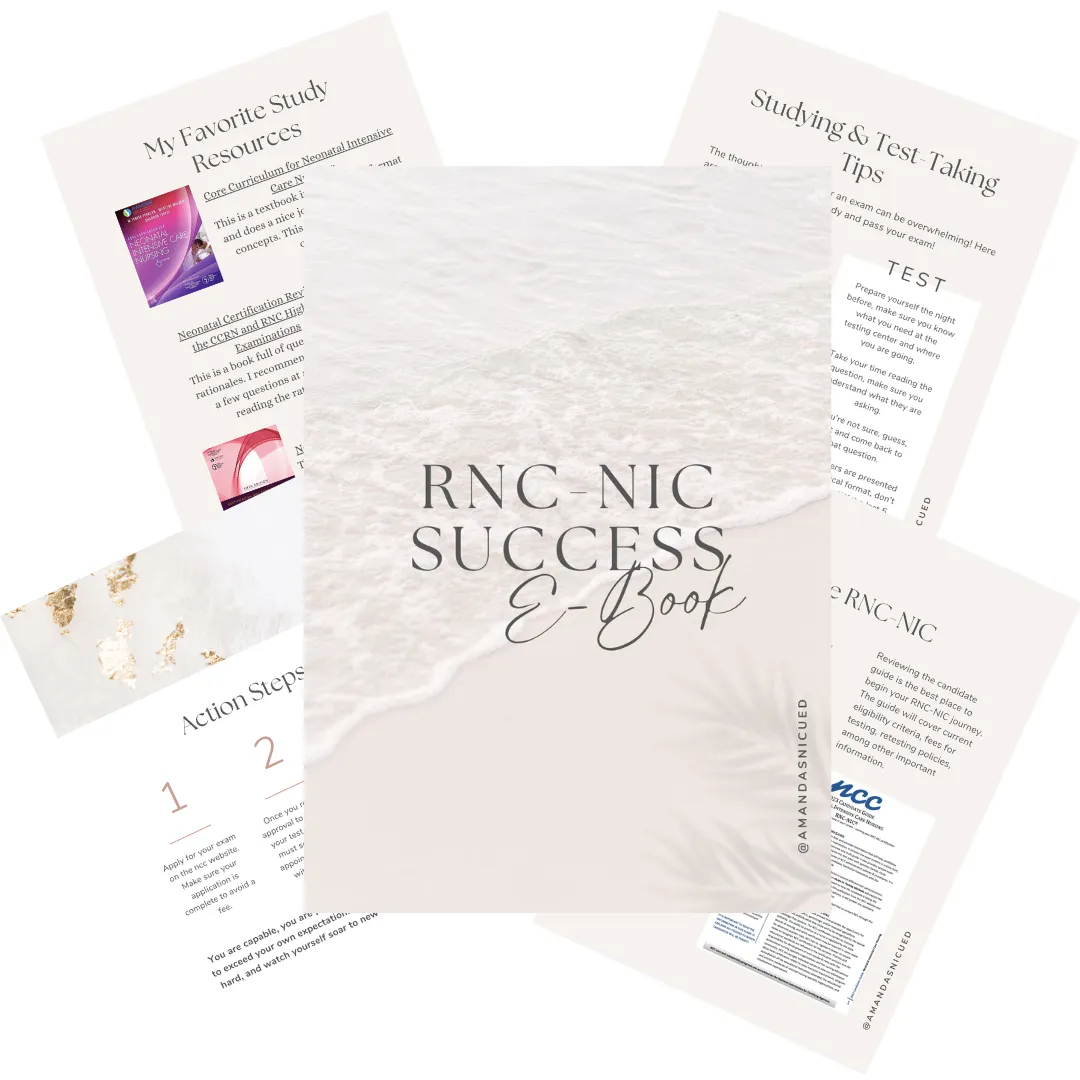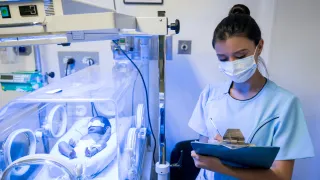
Welcome to Amanda's NICU Education




Hi! My name is Amanda. I'm a NICU nurse, Clinical Nurse Specialist, NICU Educator... basically your NICU BFF. If you want to talk NICU, I'm here for you! I love everything about NICU nursing and I'm eager to learn and share my knowledge with all my NICU friends.
I have been a NICU nurse since 2009 I am currently a Clinical Nurse Specialist in a Level IV NICU in Los Angeles.
I am passionate about educating the next generation of NICU nurses. I share my knowledge through platforms such as Instagram and Facebook and am excited to have you here on my website!
Click on the button below to sign up for my newsletter filled with NICU education and tips for all experience levels.

Not very many people love taking tests but as a self-acclaimed "forever student" who has taken (and passed) five different certification exams I am no longer afraid of tests! "Way to brag", you might be thinking but I want to help YOU pass your certification exam too!
Introducing Amanda's RNC-NIC Success digital course - your ultimate study companion!
Gain unlimited, on-demand access for life, ensuring you're primed to ace your certification exam.
I'm here to help you succeed and I can't wait for you to share with me that you PASSED the RNC-NIC EXAM!!!










Cardiac Shunts
How do you feel about cardiac shunts?
I received a great question in my Instagram DMs the other day about cardiac shunting. Do you ever feel confused about shunting? Is it left to right? Is it right to left? Why does it shunt one way vs. another? Shunting can even be bidirectional! How are you supposed to know?
I remember feeling a little lost about shunting when I was studying for the NICU certification exam. Let's review it!
First, let's review fetal circulation and the transition to extrauterine life. As you recall, in utero the fetus has very high pressure in the lungs (pulmonary vascular resistance) and low systemic pressure (systemic vascular resistance). Additionally, the fetus has a few very important shunts to allow normal fetal circulation: the ductus venosus, foramen ovale, and the ductus arteriosus. Whenever I am thinking about blood flow I always remember that blood will always flow the path of least resistance. So in the fetus, the path of least resistance is from right to left because the blood bypasses the lungs.

Once the baby is born, they cry which begins the process of decreasing the pulmonary vascular resistance (PVR). Near the same time (depending if cord clamping was early/delayed) the systemic vascular resistance (SVR) drastically increases due to the clamping of the umbilical cord. This drastic physiologic change allows the baby to transition to adult circulation. The increase in SVR causes a functional closure of the foramen ovale. Increased levels of oxygen in the blood causes the ductus arteriosus to begin to close over the first few days of life.
Ok, but I thought we were going to talk about cardiac shunting?
So when we think about shunting, it is often in the patient with a congenital heart lesion or pulmonary hypertension. Let's review some of these common defects and what direction of shunting we could expect.
Left to Right Shunts
Patent Ductus Arteriosus: As mentioned, the ductus arteriosus is an essential aspect of fetal circulation. After the baby is born the PVR drops over the days to weeks after birth. Remembering that blood flows the path of least resistance can help us visualize the hemodynamics. Since the pulmonary pressures are lower than the systemic pressures, newborns with a persistently patent ductus arteriosus can have left to right shunting. This results in pulmonary overcirculation and increased blood returning to the left side of the heart which increases the workload of the left heart. The organs and tissues receiving blood from the aorta are less perfused due to the shunting. Management of the persistent PDA is controversial but typically we are assessing to see if the shunt is hemodynamically significant. These signs include tachypnea, increased work of breathing, bounding peripheral pulses, a widened pulse pressure, a hyperactive precordium, and cardiomegaly.
Ventricular Septal Defect: A VSD is the most common congenital heart defect in newborns (good to know for the certification exam). A VSD can vary in size and location. The amount of shunting from a VSD will depend on its size and pulmonary/systemic pressures. As PVR falls there is lower pressure in the right ventricle causing a left-to-right shunt, which over time can cause symptoms of congestive heart failure. VSDs can occur in conjunction with other congenital heart defects and the shunting will vary depending on the pulmonary and systemic pressures.
Transposition of the Great Arteries: TGA requires the mixing of oxygenated and deoxygenated blood at the atrial or ventricular level for survival. A VSD is present in approximately 30-40% of patients with TGA. Shunting can occur at the atrial level via PFO or ASD, at the ventricular level via a VSD, and at the ductus arteriosus. The best site for mixing has shown to be at the atrial level and sometimes a balloon atrial septostomy will be performed to improve atrial mixing. The goal in TGA is for bidirectional balanced shunting to allow mixing between the parallel circuits. However, when a VSD is present there can be pulmonary overcirculation and signs of CHF as PVR falls. In TGA we can see a "reverse differential cyanosis" in the newborn period. In other words, the preductal saturation will be lower than the postductal saturation. As the PVR declines the pre and post-ductal saturations will equalize, with both being low.
Right to Left Shunting:
Persistent Pulmonary Hypertension: In PPHN, the PVR does not decrease the way we expect it to which results in a right-to-left shunt. Since the pulmonary pressure is so high, the blood flows from the pulmonary artery straight over to the aorta bypassing the lungs. Some even refer to PPHN as "Persistent Fetal Circulation". In right-to-left shunting, we may see differential cyanosis, meaning the preductal saturation is higher than the postductal saturation. This is due to the deoxygenated blood mixing with the oxygenated blood in the aorta via the ductus arteriosus.

Tetralogy of Fallot: ToF is the most common cyanotic congenital heart defect in newborns, and comprises of 4 abnormalities (a large VSD, RV outflow tract obstruction, Overriding aorta, and RV hypertrophy). The amount of RV outflow tract obstruction can vary and that is where we hear about the terms "pink tet" and "blue tet". A "pink tet" has mild to moderate RV outflow tract obstruction and may have adequate pulmonary blood flow (and no cyanosis). In this case, the shunting may be from left to right and result in pulmonary overcirculation. In babies with a "blue tet" there is more severe RV outflow tract obstruction which causes a right to left shunt.
Have you ever seen a baby have a "Tet Spell" aka a hypercyanotic spell? Basically, the baby has a sharp increase in PVR causing increased right-to-left shunting and cyanosis. When these happen we must act fast: calm the baby to decrease O2 demand, improve oxygenation by administering oxygen (which will decrease PVR), and increase SVR by placing the infant in a knee-to-chest position and giving an NS bolus. Performing these interventions will reduce the significant right-to-left shunt.
That was a lot of information! I hope that was a helpful review of cardiac shunting. Remember blood flows the path of least resistance. :-)
Amanda
Reference:
Basu, S., & Dobrolet, N. (2020) Congenital Defects in the Cardiovascular System in Fanaroff & Martin's Neonatal Perinatal Medicine (11th ed.).
Karlsen, K., Cowley, C. (2021). STABLE Cardiac Module: Recognition and Stabilization of Neonates with Severe CHD (2nd Ed).
Kung, G., Triedman, J. (2022). Pathophysiology of left to right shunts. Retrieved from https://www-uptodate-com.mlprox.csmc.edu/contents/pathophysiology-of-left-to-right-shunts?search=cardiac%20shunt&source=search_result&selectedTitle=1~150&usage_type=default&display_rank=1 on September 4, 2023

December 2023 Certification Review Webinar
NICU Certification Review



Ready to kickstart your journey to becoming a certified NICU nurse?
Look no further!
Grab my FREE E-Book packed with essential study and test-taking strategies for the RNC-NIC.
In the E-Book I give you the resources you need including the link to access the candidate guide, several types of books to study from, some of my favorite strategies, an outline of the content you should review, and a blank calendar for you to make your study plan!
Frequently Asked Questions About the RNC-NIC exam

What is the RNC-NIC?
The RNC-NIC is a competency-based exam that tests the specialty knowledge of nurses in the United States & Canada who care for critically ill newborns and their families.
The RNC-NICU is a nationally recognized certification that recognizes the registered nurse for their specialty knowledge and skill.

Who can take the RNC-NIC exam?
Nurses can take this exam after a minimum of two years experience in the NICU caring for critically ill newborns and their families.

Which books should I use?
I'm glad you asked! There are many excellent books to help you prepare for the RNC-NIC, I gathered ande describe each of them for you in my FREE e-book.
Is there a course to help me study?
Yes! Many hospitals host their own certification course and there are a few online courses. See my RNC-NIC test taking tips E Book for more information
What happens if I don't pass the exam?
If you don't pass the exam on your first try you can try again after 90 days. You will have to reapply after 90 days and pay a retest fee. There is no limit to the number of times you can take the exam (however a candidate can only sit for the exam twice per year).

Can I make more money if I take the RNC-NIC exam and get certified?
Yes! Many hospitals provide a raise or a bonus for nurses with specialty certifications. Hospitals also typically hire at a higher base salary when nurses have a certification.

Find me @amandasnicued on these channels or Email me
hey nurses don't miss out
© Copyright 2024. AmandasNICUEd. All rights reserved. | Terms & Conditions | Privacy Policy Contact: [email protected]

